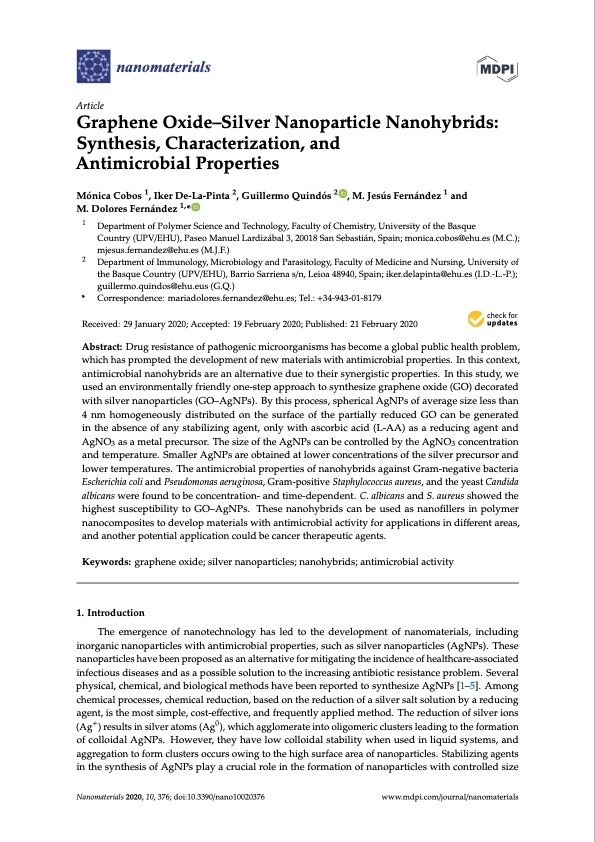
PDF Publication Title:
Text from PDF Page: 001
nanomaterials Article Graphene Oxide–Silver Nanoparticle Nanohybrids: Synthesis, Characterization, and Antimicrobial Properties Mónica Cobos 1, Iker De-La-Pinta 2, Guillermo Quindós 2 , M. Jesús Fernández 1 and M. Dolores Fernández 1,* 1 2 * Correspondence: mariadolores.fernandez@ehu.es; Tel.: +34-943-01-8179 Received: 29 January 2020; Accepted: 19 February 2020; Published: 21 February 2020 Department of Polymer Science and Technology, Faculty of Chemistry, University of the Basque Country (UPV/EHU), Paseo Manuel Lardizábal 3, 20018 San Sebastián, Spain; monica.cobos@ehu.es (M.C.); mjesus.fernandez@ehu.es (M.J.F.) Department of Immunology, Microbiology and Parasitology, Faculty of Medicine and Nursing, University of the Basque Country (UPV/EHU), Barrio Sarriena s/n, Leioa 48940, Spain; iker.delapinta@ehu.es (I.D.-L.-P.); guillermo.quindos@ehu.eus (G.Q.) Abstract: Drug resistance of pathogenic microorganisms has become a global public health problem, which has prompted the development of new materials with antimicrobial properties. In this context, antimicrobial nanohybrids are an alternative due to their synergistic properties. In this study, we used an environmentally friendly one-step approach to synthesize graphene oxide (GO) decorated with silver nanoparticles (GO–AgNPs). By this process, spherical AgNPs of average size less than 4 nm homogeneously distributed on the surface of the partially reduced GO can be generated in the absence of any stabilizing agent, only with ascorbic acid (L-AA) as a reducing agent and AgNO3 as a metal precursor. The size of the AgNPs can be controlled by the AgNO3 concentration and temperature. Smaller AgNPs are obtained at lower concentrations of the silver precursor and lower temperatures. The antimicrobial properties of nanohybrids against Gram-negative bacteria Escherichia coli and Pseudomonas aeruginosa, Gram-positive Staphylococcus aureus, and the yeast Candida albicans were found to be concentration- and time-dependent. C. albicans and S. aureus showed the highest susceptibility to GO–AgNPs. These nanohybrids can be used as nanofillers in polymer nanocomposites to develop materials with antimicrobial activity for applications in different areas, and another potential application could be cancer therapeutic agents. Keywords: graphene oxide; silver nanoparticles; nanohybrids; antimicrobial activity 1. Introduction The emergence of nanotechnology has led to the development of nanomaterials, including inorganic nanoparticles with antimicrobial properties, such as silver nanoparticles (AgNPs). These nanoparticles have been proposed as an alternative for mitigating the incidence of healthcare-associated infectious diseases and as a possible solution to the increasing antibiotic resistance problem. Several physical, chemical, and biological methods have been reported to synthesize AgNPs [1–5]. Among chemical processes, chemical reduction, based on the reduction of a silver salt solution by a reducing agent, is the most simple, cost-effective, and frequently applied method. The reduction of silver ions (Ag+) results in silver atoms (Ag0), which agglomerate into oligomeric clusters leading to the formation of colloidal AgNPs. However, they have low colloidal stability when used in liquid systems, and aggregation to form clusters occurs owing to the high surface area of nanoparticles. Stabilizing agents in the synthesis of AgNPs play a crucial role in the formation of nanoparticles with controlled size Nanomaterials 2020, 10, 376; doi:10.3390/nano10020376 www.mdpi.com/journal/nanomaterialsPDF Image | Graphene Oxide–Silver Nanoparticle Nanohybrids

PDF Search Title:
Graphene Oxide–Silver Nanoparticle NanohybridsOriginal File Name Searched:
nanomaterials-10-00376.pdfDIY PDF Search: Google It | Yahoo | Bing
Turbine and System Plans CAD CAM: Special for this month, any plans are $10,000 for complete Cad/Cam blueprints. License is for one build. Try before you buy a production license. More Info
Waste Heat Power Technology: Organic Rankine Cycle uses waste heat to make electricity, shaft horsepower and cooling. More Info
All Turbine and System Products: Infinity Turbine ORD systems, turbine generator sets, build plans and more to use your waste heat from 30C to 100C. More Info
CO2 Phase Change Demonstrator: CO2 goes supercritical at 30 C. This is a experimental platform which you can use to demonstrate phase change with low heat. Includes integration area for small CO2 turbine, static generator, and more. This can also be used for a GTL Gas to Liquids experimental platform. More Info
Introducing the Infinity Turbine Products Infinity Turbine develops and builds systems for making power from waste heat. It also is working on innovative strategies for storing, making, and deploying energy. More Info
Need Strategy? Use our Consulting and analyst services Infinity Turbine LLC is pleased to announce its consulting and analyst services. We have worked in the renewable energy industry as a researcher, developing sales and markets, along with may inventions and innovations. More Info
Made in USA with Global Energy Millennial Web Engine These pages were made with the Global Energy Web PDF Engine using Filemaker (Claris) software.
Infinity Turbine Developing Spinning Disc Reactor SDR or Spinning Disc Reactors reduce processing time for liquid production of Silver Nanoparticles.
| CONTACT TEL: 608-238-6001 Email: greg@infinityturbine.com | RSS | AMP |